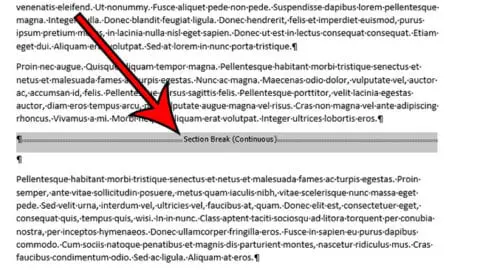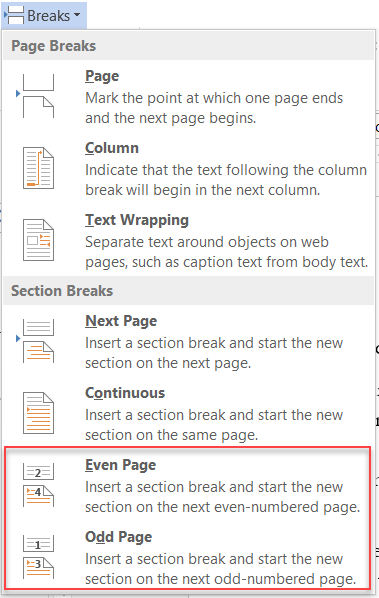
This break starts the following section on the next even-numbered page. This break creates a new section without affecting page breaks. This break starts the following section on the next page. The following types of section breaks are available: You insert a section break by clicking Breaks in the Page Setup group The following types of section breaks are available:įor example, you might want to turn a large table sideways. You insert a section break by clicking Breaks in the Page Setup To which you can apply page settings, such as orientation or margins, that are different from those of the rest of the document.įor example, you might want to turn a large table sideways. A section break identifies a part of the document In addition to page breaks, you can insert section breaks in your documents. You define for document elements such as headings. You can apply the options in the Paragraph dialog box to individual paragraphs, or you can incorporate them into the styles This option controls whether Word will break a page before the selected paragraph. This option controls whether Word will break a page within a paragraph. This option controls whether Word will break a page between the selected paragraph and the following paragraph. This option is turned on by default for all new documents. This option controls whether Word will break a page with the last line of a paragraph by itself at the top of a page or theįirst line of a paragraph by itself at the bottom of a page. You can change the following options on the Line And Page Breaks tab of the Paragraph dialog box displayed when youĬlick the Paragraph Dialog Box Launcher: Widow/Orphan Control These single lines of text can make a document hard to read, so by default Word specifies a two-line A widow is the last line of a paragraph at the top of a page, and an orphan as the first line of a paragraph at You can control whether page breaks leave widows and orphans individual lines that appear on a different page from their
#DELETING SECTION BREAK RUINS FORMATTING MANUAL#
Select any other options you want to apply, and then click OK.Īs you edit the text in a document, Word changes the location of the soft page breaks but not of any manual page breaks.Click the Number format arrow, and then in the list, click the number format you want.On the Insert tab, in the Header & Footer group, click the Page Number button, and then click Format Page Numbers.

If you want to use a numbering scheme other than Arabic numerals, number pages by chapter, or control the starting number, Page numbers, you can do so by clicking the Page Number button again and making a different selection from the Top Of Page, Bottom If you want to change the style of existing You can also position the page number in the margin at the side of the page. That is positioned at the top or bottom of the page and aligned in various ways with formatting that ranges from simple to fairlyįancy. In the Page Number gallery, you can select a page number Page Number button in the Header & Footer group on the Insert tab. If the only information you want to appear in a header or footer is the page number, you can insert it by clicking the Click Breaks in the Page Setup group on the Page Layout tab, and then click Page.Ī manual page break produces separate pages in Print Layout view, and appears as a dotted line with the words Page Break.Click Page Break in the Pages group on the Insert tab.


If you want to control how pages break, you can insert a manual page break in one of three ways: A soft page break produces separate pages in Print Layout view and is displayed as a dotted line in Draft When you add more content than will fit within the document's top and bottom margins, Word creates a new page by insertingĪ soft page break.


 0 kommentar(er)
0 kommentar(er)
